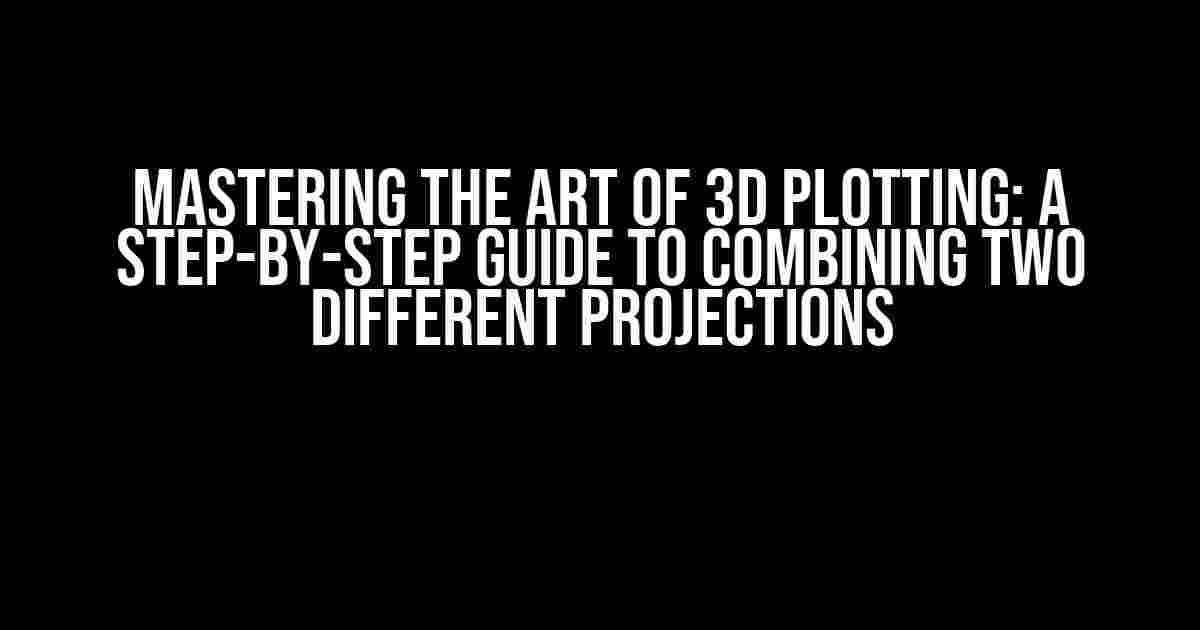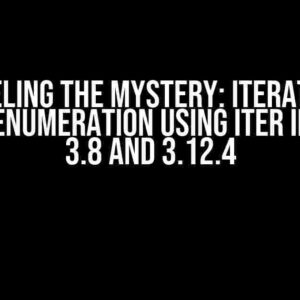Are you tired of creating 3D plots that look like they were conjured up by a magician? Do you struggle to visualize complex data from multiple angles? Fear not, dear reader, for today we’re going to demystify the process of creating a single 3D plot from two different projections. Buckle up, because we’re about to dive into a world of coordinates, rotations, and matrix multiplications!
What are Projections, Anyway?
Before we dive into the nitty-gritty, let’s take a step back and understand what projections are. In the context of 3D plotting, a projection is a way of representing a 3D object or dataset in a 2D space. There are several types of projections, including:
- Orthographic projection: a 2D representation of a 3D object, where all lines are parallel to the x, y, or z-axis.
- Perspective projection: a 2D representation of a 3D object, where lines appear to converge at a vanishing point.
- Oblique projection: a 2D representation of a 3D object, where the projection plane is not perpendicular to the x, y, or z-axis.
The Challenge: Combining Two Projections
Now, imagine you have two datasets, each with its own unique characteristics and requirements. You want to create a single 3D plot that showcases both datasets, but you’re faced with a daunting task: how do you combine two different projections into a single, cohesive plot?
The answer lies in understanding the underlying mathematics of 3D transformations. But don’t worry, we’ll break it down into manageable chunks, and by the end of this article, you’ll be a master of combining projections like a pro!
Step 1: Prepare Your Data
Before we dive into the world of 3D transformations, let’s make sure our data is in order. Assuming you have two datasets, `dataset1` and `dataset2`, each with its own set of x, y, and z coordinates, let’s prepare them for plotting:
import numpy as np # Load dataset1 dataset1_x = np.array([...]) dataset1_y = np.array([...]) dataset1_z = np.array([...]) # Load dataset2 dataset2_x = np.array([...]) dataset2_y = np.array([...]) dataset2_z = np.array([...])
Step 2: Define Your Projections
Next, we need to define the two projections we want to combine. For this example, let’s use an orthographic projection for `dataset1` and a perspective projection for `dataset2`. We’ll use the `matplotlib` library to create our projections:
import matplotlib.pyplot as plt
from mpl_toolkits.mplot3d import Axes3D
# Create figure and axis objects
fig = plt.figure()
ax1 = fig.add_subplot(121, projection='3d')
ax2 = fig.add_subplot(122, projection='3d')
# Define orthographic projection for dataset1
ax1.set_xlabel('X')
ax1.set_ylabel('Y')
ax1.set_zlabel('Z')
ax1.view_init(elev=30, azim=-60)
# Define perspective projection for dataset2
ax2.set_xlabel('X')
ax2.set_ylabel('Y')
ax2.set_zlabel('Z')
ax2.view_init(elev=45, azim=30)
Step 3: Combine the Projections
Now, we need to combine the two projections into a single 3D plot. To do this, we’ll use the `Axes3D` object’s `add_collection3d` method to add the second projection to the first:
# Add dataset1 to ax1 ax1.scatter(dataset1_x, dataset1_y, dataset1_z) # Add dataset2 to ax2 ax2.scatter(dataset2_x, dataset2_y, dataset2_z) # Combine the two projections ax1.add_collection3d(ax2.artists[0])
Step 4: Rotate and Transform the Plot
To create a seamless integration of the two projections, we need to rotate and transform the plot to ensure the two datasets align properly. We’ll use the `Axes3D` object’s `view_init` method to adjust the elevation and azimuth of the plot:
# Rotate the plot to align the two datasets ax1.view_init(elev=40, azim=-30)
Step 5: Customize and Refine
Finally, let’s customize our plot to make it more visually appealing. We can add labels, titles, and adjust the axis limits to our liking:
# Add labels and title
ax1.set_xlabel('X')
ax1.set_ylabel('Y')
ax1.set_zlabel('Z')
ax1.set_title('Combined 3D Plot')
# Adjust axis limits
ax1.set_xlim(-10, 10)
ax1.set_ylim(-10, 10)
ax1.set_zlim(-10, 10)
# Show the plot
plt.show()
The Result
And there you have it! A single 3D plot combining two different projections. With this powerful technique, you can showcase complex data from multiple angles, giving your audience a deeper understanding of the relationships between different variables.
| Dataset1 | Dataset2 |
|---|---|
 |
 |
 |
|
By following these steps, you can create stunning 3D plots that reveal the hidden patterns and relationships in your data. Remember, the key to mastering 3D plotting is to understand the underlying mathematics and to experiment with different projections and transformations.
Conclusion
In conclusion, combining two different projections into a single 3D plot is a powerful technique for data visualization. By following the steps outlined in this article, you can create complex, yet intuitive, plots that showcase multiple datasets from different angles. So, go ahead, get creative, and unleash the full potential of 3D plotting!
- Prepare your data by loading and preparing your datasets.
- Define your projections using the `Axes3D` object.
- Combine the two projections using the `add_collection3d` method.
- Customize and refine the plot to your liking.
Happy plotting, and remember to stay creative!
Frequently Asked Question
Combining two different projections into one 3D plot can be a bit tricky, but don’t worry, we’ve got you covered! Here are some answers to your most pressing questions:
What are the two types of projections I can combine to create a 3D plot?
You can combine two types of projections: Orthographic (2D) projection and Perspective (3D) projection. Orthographic projections are used to create 2D views of an object, while Perspective projections create a 3D view by converging lines to a vanishing point. Combining these two types of projections can create a stunning 3D plot.
What is the benefit of combining two projections into one 3D plot?
Combining two projections into one 3D plot allows you to visualize complex data from multiple angles, providing a more comprehensive understanding of the data. This technique is particularly useful for visualizing 3D geometric shapes, molecular structures, and engineering designs.
Can I combine multiple projections from different software?
Yes, you can combine projections from different software, such as MATLAB, Python, or Blender, as long as they can export data in a compatible format. This allows you to leverage the strengths of each software and create a more comprehensive 3D plot.
What kind of data can I visualize using this technique?
You can visualize a wide range of data, including 3D geometric shapes, molecular structures, engineering designs, medical imaging data, and even astronomical data. The key is to ensure that the data is compatible with the software and projection types you are using.
What skills do I need to create a 3D plot from two different projections?
To create a 3D plot from two different projections, you’ll need basic knowledge of programming languages like Python or MATLAB, as well as experience with 3D visualization software like Blender or Maya. You’ll also need to understand the fundamentals of 3D geometry and projection techniques.



